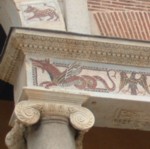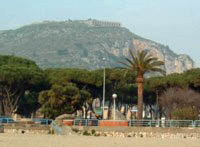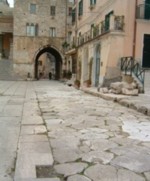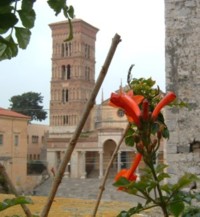Terracina is a pleasant seaside resort in the south of the Lazio region, between Rome and Naples. It was an important port on the Roman Appian Way, and the site of a major temple to Jupiter. Nowadays the modern town spreads out on the plain below the hills, along a wide sandy beach which attracts many summer visitors.

Things to see in Terracina
The modern part of Terracina is unexciting but pleasant, with wide tree-lined boulevards leading to the beach west of the port. The sea and the sand are the town’s main attraction for many of its Italian summer visitors. Ferries depart from the port for the Pontine Islands. A boat-lined canal leads to the harbour from the bus station area, passing the fish-hall where crates are loaded with fresh fish, and wizened old salts sit and chat on a terrace.
For more charm and historical interest, however, head for the Centro Storico, the old part of town. This lies uphill from the bus station (cross the road and find a steep hidden staircase, or take a narrow sloping road uphill). The heart of historical Terracina is Piazza del Municipio, a pretty piazza containingpaving stones from the Roman Forum, a crumbling archway, the town cathedral, the headquarters of the town council and the archaeological museum. Close by you can also see an ancient paved stretch of the Appian Way.
The Cathedral (shut at lunchtimes) was built over a Roman temple to Augustus, and is an attractive building composed of a mixture of styles. Note the picture of the town on the right-hand altar (one of three decorated altars). The stone pulpit resting on four carved animals is also worth a glance. Outside there is a large stone Roman basin on display in the portico, which was supposedly used for boiling Christians, and a pretty frieze of animals tops the colonnades.

The small Museo Civico contains ancient sculptures found in the area, and also offers a selection of guide and leaflets for sale, including a useful fold-out guide to the Temple of Jupiter.
The old town and the archaeological remains continue through the archway alongside the cathedral, where carved columns and patterned walls are exposed to view. Further on, the winding medieval streets offer a pleasant opportunity for strolling and discovering atmospheric shops and restaurants. More ruins are dotted around the upper and lower parts of town; a guide can be picked up from the museum which will help you find them.
Terracina’s most unusual and striking site is the Temple of Jupiter Anxur. Anxur was the ancient Volscian name for the town; Jupiter has generally been assumed to be the deity to whom the sanctuary was dedicated. The main part of the temple is gone, but the impressive vaulted base can be seen for miles, and no visitor to Terracina should miss a trip to the fascinating hilltop site with its superb views.
At the eastern end of town, below the temple on its hill, is a monument to Roman engineering and determination. To improve the route of the Appian Way (which previously had to head inland over the hills), Trajan had the cliff cut to make way for the road. Traffic still runs past this 36m-deep cut in the rock, the Pisco Montano; axe-marks and Roman numerals indicate the workers’ progress.
Cheap bars and takeaways can be found along Via Roma, including the pirate-themed Morgan Bay, where you can eat your pizza slice at indoors tables. If you want to buy a picnic, there are a couple of supermarkets along the sea-canal, and another on the way up to the temple (closed lunchtimes). Bars, pasticcerie, gelaterie and clothes shops line Via della Vittoria, which runs down to the lungomare, the seafront.
Terracina travel information

Terracina is reachable from Rome or from Naples and can be managed as a day trip from either city.
The town does have its own railway station on a branch line, but it’s only served by a couple of train services every day. If you are relying on public transport, you will find the frequent Cotral bus services more useful. There are buses direct from Rome EUR Fermi; the journey takes just over two hours.
For a speedier and more comfortable journey, however, the best method is to combine rail and bus travel. First you should take a train to Monte S. Biagio station on the Rome – Naples railway line. Only the slower train services – approximately hourly – stop at the station. Cotral buses to Terracina stop outside Monte S. Biagio station (generally on the far side of the road). Bus tickets cost 1 and can be bought at the news kiosk alongside the station (as can rail tickets). The bus journey takes fifteen minutes – look out of the window to see interesting ruins dotted along this section of the Appian Way.
In Terracina buses stop at the main bus station in Piazza 25 Aprile, below the old town. From here, Cotral services run to other destinations in the Province of Latina (including several other FS train stations); useful timetables are displayed in a kiosk. Smaller orange urban buses are based in Piazza 25 Aprile and Piazzale Marconi.
Accommodation
Hotels in Terracina tend to cater for the Italian summer crowds who come here for the beaches, and they don’t offer particularly inspiring accommodation. However, it’s a nice town and for a night or two the hotels – mostly modern and rather anonymous – are fine. If you’re coming here for a beach holiday, read other guests’ reviews before booking.
> Terracina hotels, B&Bs and holiday rentals
On this site
Useful links
Lazio destinations
- About the Lazio region
- Anzio
- Bracciano
- Calcata
- Castel Gandolfo
- Castelli Romani
- Cerveteri
- Formia
- Frascati
- Gaeta
- Palestrina
- Pontine islands
- Ponza
- Rome
- Sperlonga
- Terracina
- Tivoli
- Ventotene
- Viterbo
